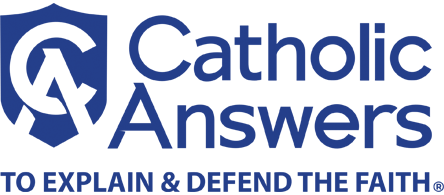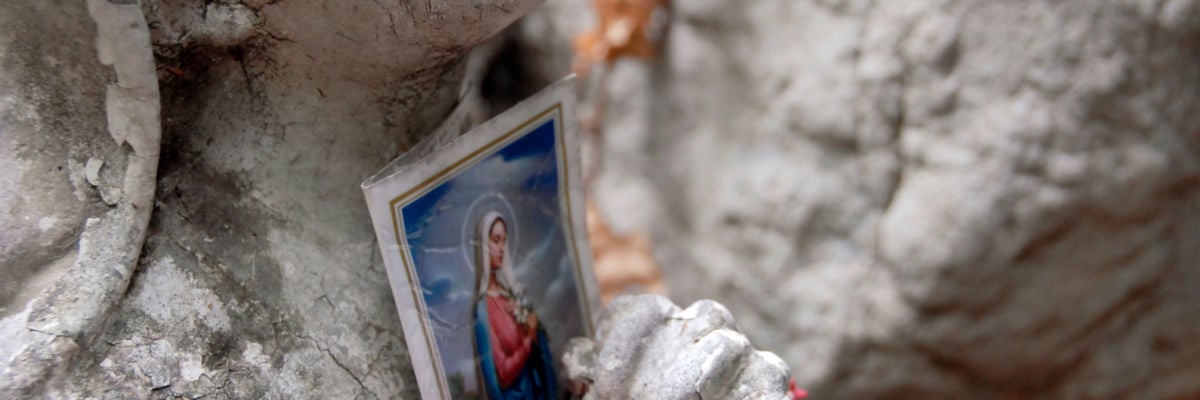
Having just written a book dedicated to “both/and,” I was thrilled to stumble on a clip of Gavin Ortlund—a sharp and cordial Protestant apologist with a substantial following on YouTube—reflecting on whether the principle can appropriately be applied to Jesus and Mary.
Ortlund regularly draws not only on Protestant thinkers, but also on Catholic apologists like Pascal, Chesterton, and Peter Kreeft. It’s likely he knows all the standard apologetic responses and counter-responses to Marian skepticism. My hope is that by circling around his comments from this vantage of the both/and, and finding some common ground, we might gain a fresh perspective and perhaps clarify where the disagreement really lies.
In the full video, Ortlund defends the Marian title “Mother of God” (theotokos) but seems not to want to go beyond that:
Think of it just like this, to be simple: Mary is theologically important in relation to Jesus. But when she starts being disconnected and pulled over here, and now we’ve got this whole new theological enterprise devoted at her, that can have the effect of taking focus away from Jesus.
I appreciate his use of and emphasis on the word “can” here. Can Mariology go too far? This is a different question from whether it just is too far already simply by being Marian.
I think the answer—though Catholics are admittedly sluggish to admit this—is plainly yes: it can go too far. The obvious historical case in point is the Collyridians, a fourth-century sect that offered bread or cakes in sacrifice to Mary, giving her the latria (worship) due only to God. As Patrick Madrid points out, this isn’t just a remote danger of the ancient goddess-worshiping past: “Collyridianism is seen today in various forms. Those ‘hyper-Marian’ groups and writers who overly exalt Mary and focus on her to the exclusion (or near exclusion) of Christ are guilty of something approaching idolatry.” That we should at least take the danger seriously is well attested by the first of the ten commandments, Christ’s “greatest commandment,” and really the whole arc of the scriptures.
Ortlund goes on:
We often hear that it’s always a both/and. People say, “No, no, no; the more we love Mary, the more we love Jesus. They’re not competitive.” But some things can be an either/or.
The introduction of the categories of both/and and either/or are striking, especially in light of Ortlund’s use of Karl Barth and Martin Luther to make his case. Both men played decisive roles in the development of these concepts in theology, and as Hans Urs von Balthasar points out, they represent a strain of theological thought with a particular allergy to—or, in Kierkegaard’s words, “an indescribable horror of”—the both/and instinct: “The ‘Catholic both . . . and,’” Balthasar writes, “has always appeared as a compromise in the eyes of the Augustinians, who think things out to the end, and who include Luther and Karl Barth.”
Some things are indeed either/or. This includes logical contradictions (we can’t coherently claim both x and non-x; only one can be true), moral absolutes (we can’t marry good and evil, heaven and hell; only one can be the direction in which we move); and most importantly, the primacy of God (we can’t serve both God and mammon; there can only be one first place in our hearts, only one aim of our worship, only one God and one Mediator—1 Tim. 2:5). In short, the both/and doesn’t extend into irrationality, immorality, or idolatry. If we fail to erect these boundaries, the principle will go off track.
Ortlund offers John 3:30 as an example of an either/or:
John the Baptist didn’t say, “He must increase, and I must increase, too, because it’s a both/and.” He said, “He must increase, and I must decrease.”
Here, the increase or decrease zero-sum game is clearly over the identity of the Messiah—that is, the question of who has the primacy. But then Ortlund—begging the question—ties this example to Mariology:
In principle it’s at least possible for a focus upon Mary or any other person to displace a focus upon Christ. I’m amazed, frankly, at the naïveté and lack of concern about this. . . .
What about when Christians love Jesus less than they love Mary and pray to Jesus less than they pray to Mary? And is that always a both/and? Can’t you see that sometimes it’s not a both/and? . . .
We can commit idolatry and put someone else functionally in our hearts in the role that Jesus alone should have, and Protestants do it all the time. Everybody can do it. It’s a perennial temptation.
But what is the precise character of Mariology as it unfolds in the Catholic Church? Is it an increase of Mary where she should decrease—that is, with respect to the identity of the Savior? Or is it, as Ortlund defended at the outset, an extended meditation on Mary’s relation to Jesus? Ortlund subtly suggests the first option: Mariology is inherently dysfunctional and dangerous—far more trouble than it’s worth—and we ought to let it pass us by.
But the question behind the question is precisely the definition—and limits—of the “Catholic both/and.” What is the both/and in a healthy biblical sense? It’s what I’ve called “the Way of heaven and earth”—the communion of God and man, God’s “place” and man’s “place,” the spiritual and the physical, and the spirit and the flesh in salvation history. At the center of that history is Christ, who holds all these realities together in his person. The primary “both/and” is the union of God and man in the Incarnation: Christ has two distinct natures, divine and human, united in his person. A whole series of both/ands flow out from this inflection point: both the spiritual and the physical are united in the sacraments. (Ortlund, though a Baptist, believes in the Real Presence.) Both heaven and earth will be in the new creation. Both spirit and flesh will be resurrected on the last day. And so on.
What about Mary? Gabriel declares to her, “Greetings, favored one! The Lord is with you. . . . You have found favor with God. . . . The Holy Spirit will come upon you, and the power of the Most High will overshadow you” (Luke 1:28, 30, 35). And after her fiat, her perfect yes to God’s will, she sings,
My soul magnifies the Lord,
and my spirit rejoices in God my Savior,
for he has looked with favor on the lowliness of his servant.
Surely, from now on all generations will call me blessed;
for the Mighty One has done great things for me,
and holy is his name (vv. 46-49).
We might paraphrase these words using the precise formula Ortlund doesn’t see in John: He must increase, and I must increase, too. Mary is transparent to the Lord God and lives only to make him great—and God blesses and exalts her in return. In her glorifying of God, she is glorified. We see this same rhythm between Mary and God the Son. She counsels us to do whatever Christ tells us (John 2:5)—and Christ tells us, from the cross, that she is our mother (John 19:27). From that hour, the beloved disciple takes her into his home—as countless Catholics have done since in prayer and devotion. The Church magnifies Mary because Christ magnifies Mary, and Christ magnifies Mary because Mary magnifies Christ.
This is the heart of Mariology: everything the Church teaches about Mary does, in fact, relate to Jesus, as Ortlund argues it should. At the center of the Hail Mary prayer is the holy name of Jesus; woven through the rosary are the great mysteries of his life. Her perpetual virginity, immaculate conception, assumption—though it might be harder to see at first—emerge, like the title “Mother of God,” out of the same sustained reflection on the Incarnation.
In short, our love for and attention to Mary, as a rule, increases our love for and attention to Jesus. “Never be afraid of loving the Blessed Virgin too much,” St. Maximilian Kolbe counseled. “You can never love her more than Jesus did.” In order to “risk” the first part of that advice, we must bear in our minds and hearts the second: that Mary matters because Jesus matters, and that we call her blessed because God so richly blessed her. We don’t have to fear idolatry in loving her—even in loving her lavishly.
Rather than John the Baptist’s “I must decrease,” we find a more apt analogy for Mariology in Christ’s “Greatest Commandment”: “You shall love the Lord your God with all your heart, and with all your soul, and with all your mind.’ This is the greatest and first commandment. And a second is like it: ‘You shall love your neighbor as yourself.’ On these two commandments hang all the law and the prophets” (Matt. 22:37-40). A few chapters later, we hear in the parable of the sheep and the goats: “Truly I tell you, just as you did it to one of the least of these who are members of my family, you did it to me’” (25:40).
Are our love for God and our love for our neighbor in competition? Is this an either/or? On the contrary: although the love of God comes first, we love God best precisely through our love for our neighbor, especially “the least of these.” God doesn’t want our love for him at the expense of our love for his creatures—being, as Johnny Cash sang, so heavenly minded we’re no earthly good—but rather, our love for both Creator and creature, in and through his Son. So, too, with our love for both the Son of God and the Mother of God.
I would conclude with an invitation to Ortlund, one that flips his challenge on its head: can’t you see that sometimes it is a both/and? That, in principle, it’s possible for Mary not to detract from Christ, but on the contrary, to intensify our love for him and for his people?
Granting both possibilities, how do we determine whether swimming with the current of Mariology increases or decreases Christ on the ground, in actual practice? The only way to know for sure is to experience Mariology “from the inside.” There we see that it’s all about Jesus—“to Jesus through Mary,” as the Marian adage has it.
Marian devotion is stubbornly Christocentric, because Mary is never far from her son. She doesn’t get in the way. On the contrary, she shows the Way.



